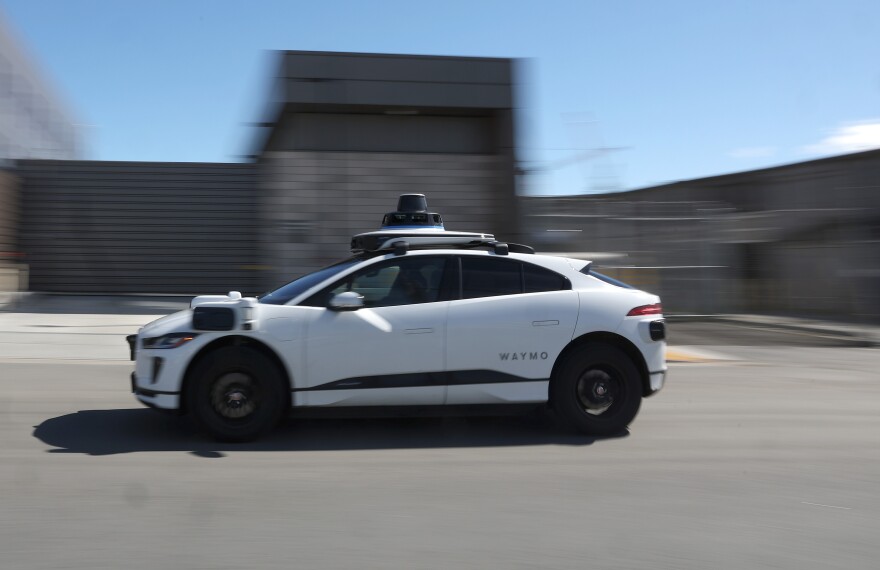Truth matters. Community matters. Your support makes both possible. LAist is one of the few places where news remains independent and free from political and corporate influence. Stand up for truth and for LAist. Make your year-end tax-deductible gift now.
Waymo is taking on LA freeways. Keep calm and carry on

Waymo has been operating its fleets of autonomous taxis in greater Los Angeles for more than a year, expanding the areas its all-electric Jaguars service to 79 square miles between Santa Monica and downtown.
The company was given the regulatory go-ahead to drive on freeways last summer. And now, after more than 1.9 million miles clocked on the mean streets of L.A., Waymo is finally ready to take on our glorious city's most stereotypical and notorious feature.
So how is Waymo going to fare crossing multiple lanes of the 110 to hit the 10 interchange during afternoon rush-hour on a Friday of a long holiday weekend?
"Actually, freeways are easier than surface streets," said Rahul Jain, a professor of electrical and computer engineering at USC, with a research focus on autonomous driving. "Surface streets are much harder."
Freeways are easier?
That's because our local streets are filled with things that disrupt or control the flow of traffic. Think stop signs, traffic lights, pedestrians, little delivery bots.
Essentially, there are fewer variables on the freeway. Speed is one of them, Jain said. Being able to stay in your lane is another.
He added that technologies to control for those factors already exist in cars today, meaning hands-free freeway driving is largely already a reality — Waymo or no Waymo.
"There is active cruise control," Jain said. "If the vehicle in front, for example, slows down, then the car will also slow down — as opposed to cruise control, where it doesn't do that."
Lane assist or lane keeping, Jain added, is a common feature that keeps cars from veering out of lane.
But Jain said Waymo obviously has some major technological legs up over other cars — including the ability to "see" in 360 degrees around the car at all times, allowing for lane changes.
We reached out to Waymo to learn its plan to tackle freeway driving. The company wasn’t able to provide someone to speak to us before publication.
Getting stumped
Still, as equipped as Waymos are, Jain said in the parlance of engineering, there will always be "edge" or "corner" cases — outlier situations, the unknown-unknowns.
For example, if we hear sirens, what we are supposed to do is to pull over to let the emergency vehicle through. That kind of scenario, Jain said, could stump an autonomous vehicle.
All in all, Jain said, he thinks Waymo will do just fine on our interstates. After all, this test period — where only company staffers are allowed to ride in the cars — is precisely designed for Waymo to learn from these kinks.
It's an assessment that Jiaqi Ma, director of UCLA’s Mobility Center of Excellence, agrees with. Freeways are "more predictable, frankly," Ma said.
But speed means decisions need to be made faster.
" Functionally, it has to be capable of dealing with those emergent conditions very fast," Ma said.
"I think the technology is pretty ready now, and this technology has to be tested, deployed and tested," Ma added. "This is exactly what they're doing now. They are testing it in different cities, different environments."
Not totally autonomous
It's rinse and repeat until the technology holds its own against our complex road systems.
Ma said Waymo is not operating currently as a fully autonomous car. It's at Level 4, he said, out of five.
" That means some humans got to be in the loop, right? There are remote operators — remote assistance to support these vehicles," Ma said.
He said he doesn't know if the driverless taxi service will ever be operating in the wild at full autonomy because there are too many surprises that even a growing data set might not be able to account for.
" It's a tricky engineering question. I hope it will happen, but there are still a lot of technical issues to be resolved," he said.
In the meantime, don't be alarmed when you see a Waymo alongside you on the 10 — it's just another day on L.A.'s freeways.











